

Compact Muon Solenoid
LHC, CERN
| CMS-PAS-HIG-17-028 | ||
| Combined measurement and interpretation of differential Higgs boson production cross sections at √s= 13 TeV | ||
| CMS Collaboration | ||
| July 2018 | ||
| Abstract: The differential Higgs boson production cross sections are sensitive probes for new physics beyond the standard model. In particular, new physics may contribute in the gluon-gluon fusion loop, the dominant Higgs boson production mechanism at the LHC, and manifest itself as deviations from the expected standard model distributions. Combined spectra from the H→γγ, H→ZZ and H→bˉb decay channels are presented, together with limits on the Higgs couplings using 35.9 fb−1 of proton-proton collision data recorded with the CMS detector at √s= 13 TeV. | ||
|
Links:
CDS record (PDF) ;
CADI line (restricted) ;
These preliminary results are superseded in this paper, PLB 792 (2019) 369. The superseded preliminary plots can be found here. |
||
| Figures & Tables | Summary | Additional Figures | References | CMS Publications |
|---|
| Figures | |

png pdf |
Figure 1:
(left) Scan of the total cross section σtot, based on a combination of the total cross sections from H→γγ (64.0 ± 9.6 pb) and H→ZZ (58.2 ± 9.8 pb. (right) Scan of the ratio of branching fractions R based on a combination of H→γγ and H→ZZ, while profiling all other parameters. The filled markers indicate the one standard deviation interval. |

png pdf |
Figure 1-a:
Scan of the total cross section σtot, based on a combination of the total cross sections from H→γγ (64.0 ± 9.6 pb) and H→ZZ (58.2 ± 9.8 pb. The filled markers indicate the one standard deviation interval. |
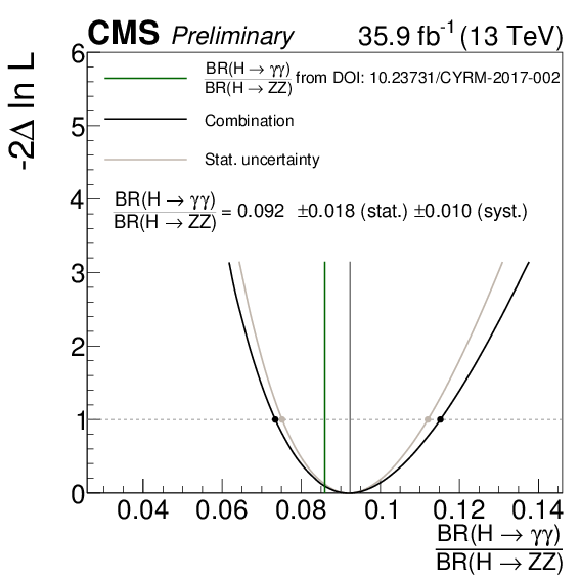
png pdf |
Figure 1-b:
Scan of the ratio of branching fractions R based on a combination of H→γγ and H→ZZ, while profiling all other parameters. The filled markers indicate the one standard deviation interval. |
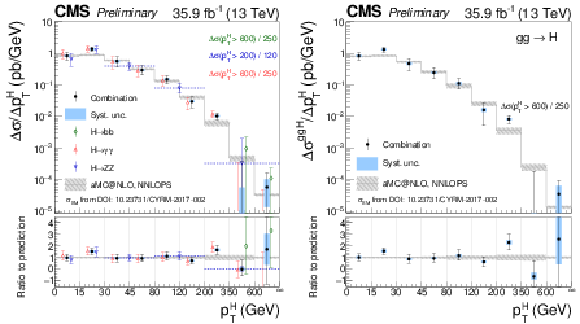
png pdf |
Figure 2:
Best fit values and uncertainties of the cross sections and signal strengths. (left) pTH. (right) pTH while fixing non-gluon-fusion contributions to their SM expectation. |

png pdf |
Figure 2-a:
Best fit values and uncertainties of the cross sections and signal strengths: pTH. |
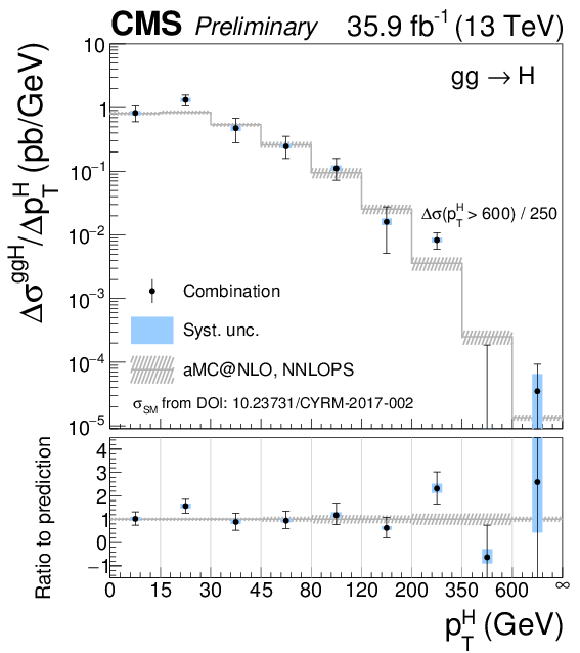
png pdf |
Figure 2-b:
Best fit values and uncertainties of the cross sections and signal strengths: pTH while fixing non-gluon-fusion contributions to their SM expectation. |
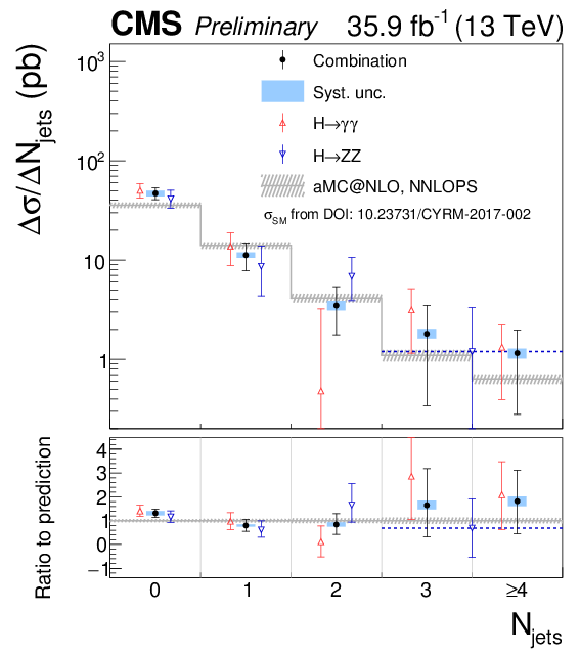
png pdf |
Figure 3:
Best fit values and uncertainties of the cross sections and signal strengths for the Njets-spectrum. |
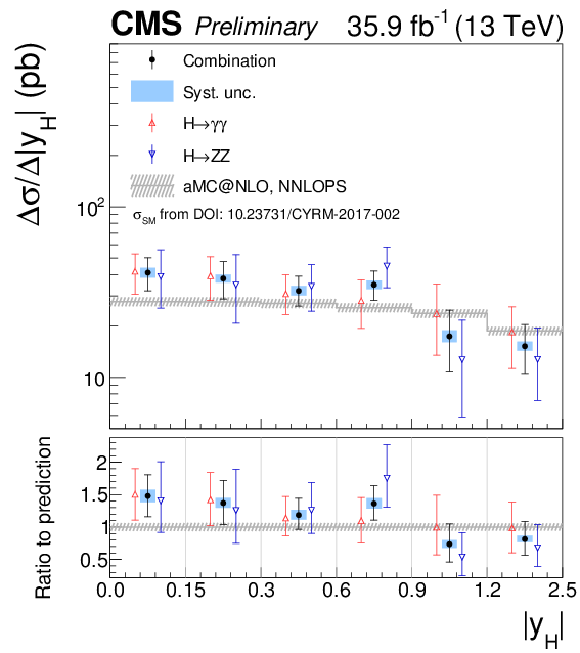
png pdf |
Figure 4:
Expected best fit values and uncertainties of the cross sections and signal strengths for the |yH|-spectrum. |
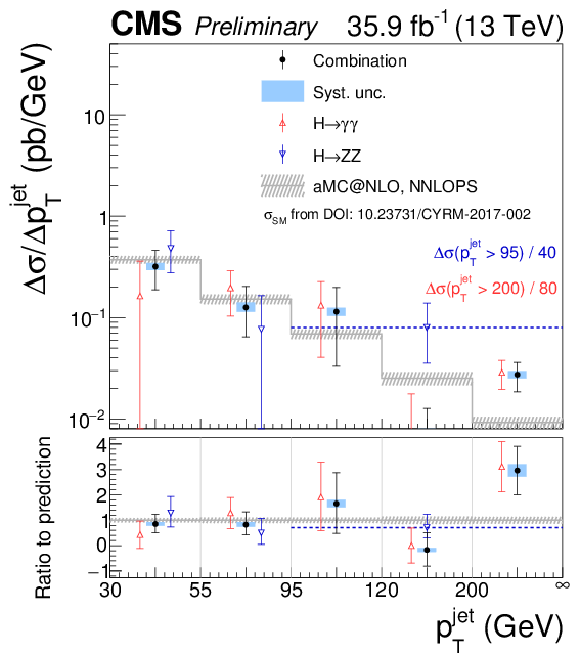
png pdf |
Figure 5:
Expected best fit values and uncertainties of the cross sections and signal strengths for the pTjet-spectrum. |

png pdf |
Figure 6:
Simultaneous fit results for κb and κc. (left) One and two standard deviation contours are shown for the combined (H→γγ and H→ZZ) fit to data and for H→γγ and H→ZZ separately, assuming a coupling dependency of the branching fractions. (right) One and two standard deviation contours are shown for the combined (H→γγ and H→ZZ) fit to data and for H→γγ and H→ZZ separately, assuming freely floating branching fractions. |

png pdf |
Figure 6-a:
Simultaneous fit results for κb and κc. One and two standard deviation contours are shown for the combined (H→γγ and H→ZZ) fit to data and for H→γγ and H→ZZ separately, assuming a coupling dependency of the branching fractions. |
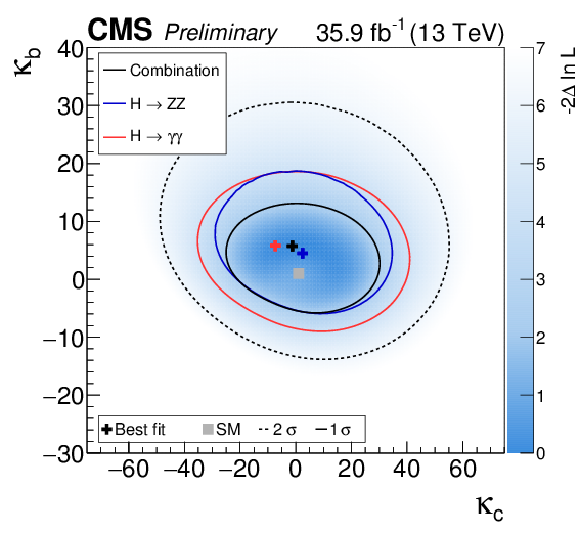
png pdf |
Figure 6-b:
Simultaneous fit results for κb and κc. One and two standard deviation contours are shown for the combined (H→γγ and H→ZZ) fit to data and for H→γγ and H→ZZ separately, assuming freely floating branching fractions. |

png pdf |
Figure 7:
Scans of only one coupling, while profiling the other. The filled markers indicate the one standard deviation interval. The branching fractions were considered dependent on the values of the couplings. (left) Scan of κb while profiling κc. (right) Scan of κc while profiling κb. |
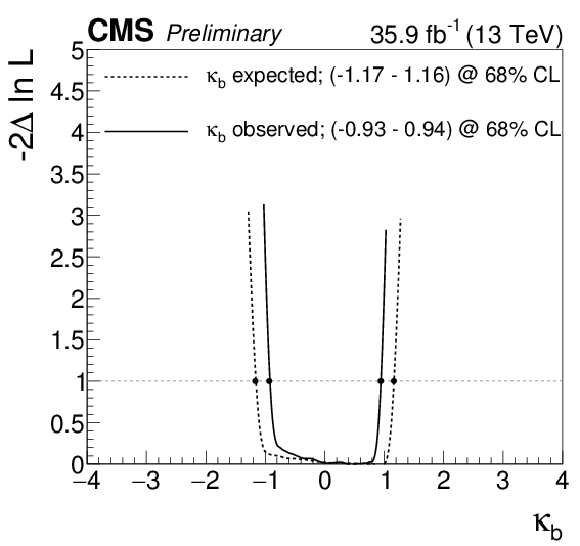
png pdf |
Figure 7-a:
Scan of κb while profiling κc. The filled markers indicate the one standard deviation interval. The branching fractions were considered dependent on the values of the couplings. |
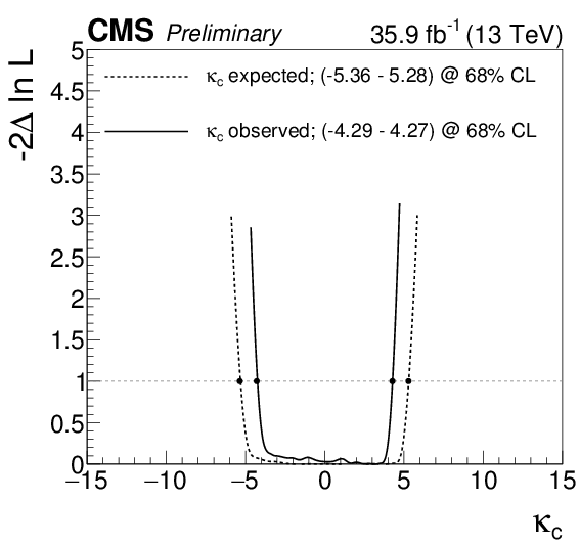
png pdf |
Figure 7-b:
Scan of κc while profiling κb. The filled markers indicate the one standard deviation interval. The branching fractions were considered dependent on the values of the couplings. |

png pdf |
Figure 8:
Scans of only one coupling, while profiling the other. The filled markers indicate the one standard deviation interval. The branching fractions were freely floated in the fit. (left) Scan of κb while profiling κc. (right) Scan of κc while profiling κb. |
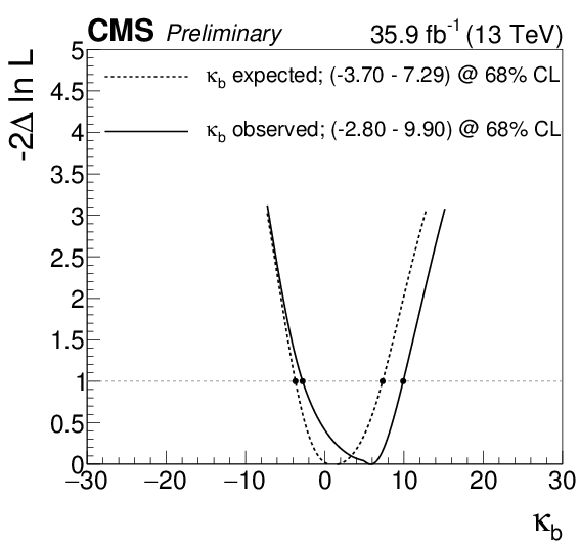
png pdf |
Figure 8-a:
Scan of κb while profiling κc. The filled markers indicate the one standard deviation interval. The branching fractions were freely floated in the fit. |
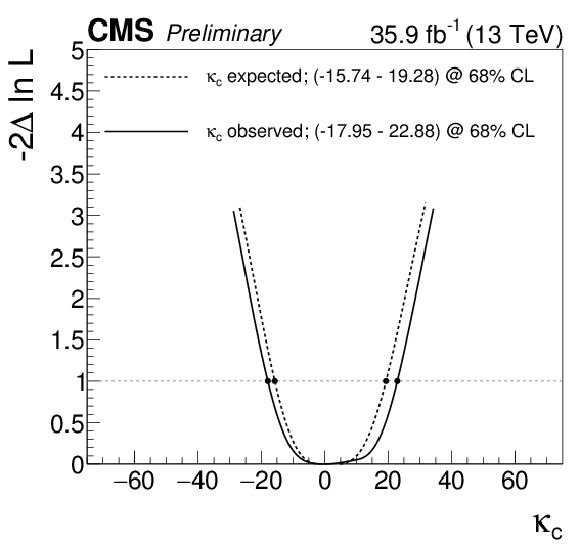
png pdf |
Figure 8-b:
Scan of κc while profiling κb. The filled markers indicate the one standard deviation interval. The branching fractions were freely floated in the fit. |

png pdf |
Figure 9:
Simultaneous fit results for κt and cg. (left) One and two standard deviation contours are shown for the combined (H→γγ, H→ZZ and H→bˉb) fit to data and for H→γγ and H→ZZ separately, assuming a coupling dependency of the branching fractions. (right) One and two standard deviation contours are shown for the combined (H→γγ, H→ZZ and H→bˉb) fit to data and for H→γγ and H→ZZ separately, assuming freely floating branching fractions. |

png pdf |
Figure 9-a:
One and two standard deviation contours are shown for the combined (H→γγ, H→ZZ and H→bˉb) fit to data and for H→γγ and H→ZZ separately, assuming a coupling dependency of the branching fractions. |
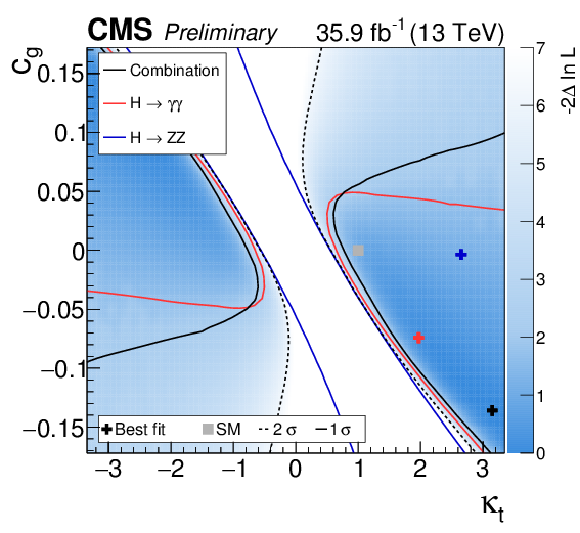
png pdf |
Figure 9-b:
One and two standard deviation contours are shown for the combined (H→γγ, H→ZZ and H→bˉb) fit to data and for H→γγ and H→ZZ separately, assuming freely floating branching fractions. |

png pdf |
Figure 10:
Simultaneous combined fit results for κt and κb. (left) One and two standard deviation contours are shown for the combined (H→γγ, H→ZZ and H→bˉb) fit to data and for H→γγ and H→ZZ separately, assuming a coupling dependency of the branching fractions. (right) One and two standard deviation contours are shown for the combined (H→γγ, H→ZZ and H→bˉb) fit to data and for H→γγ and H→ZZ separately, where the branching fractions were freely floated in the fit. |

png pdf |
Figure 10-a:
One and two standard deviation contours are shown for the combined (H→γγ, H→ZZ and H→bˉb) fit to data and for H→γγ and H→ZZ separately, assuming a coupling dependency of the branching fractions. |

png pdf |
Figure 10-b:
One and two standard deviation contours are shown for the combined (H→γγ, H→ZZ and H→bˉb) fit to data and for H→γγ and H→ZZ separately, where the branching fractions were freely floated in the fit. |
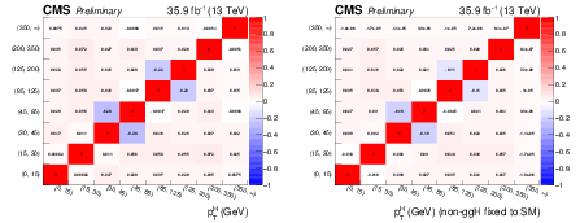
png pdf |
Figure 11:
(left) Bin-to-bin correlation matrix of the pTH-spectrum. (right) Bin-to-bin correlation matrix of the pTH-spectrum, while keeping the non-gluon-fusion contributions (xH) fixed to SM expectation. |
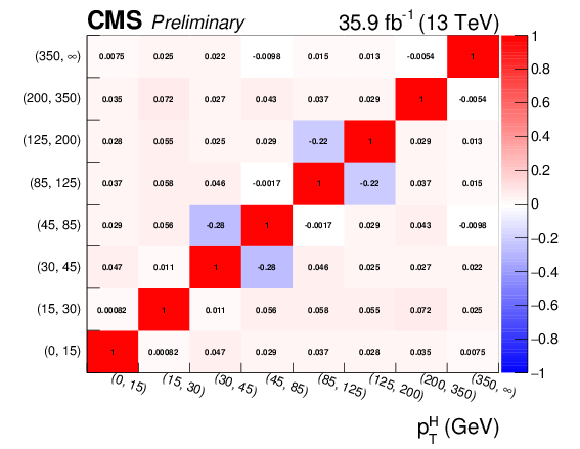
png pdf |
Figure 11-a:
Bin-to-bin correlation matrix of the pTH-spectrum. |
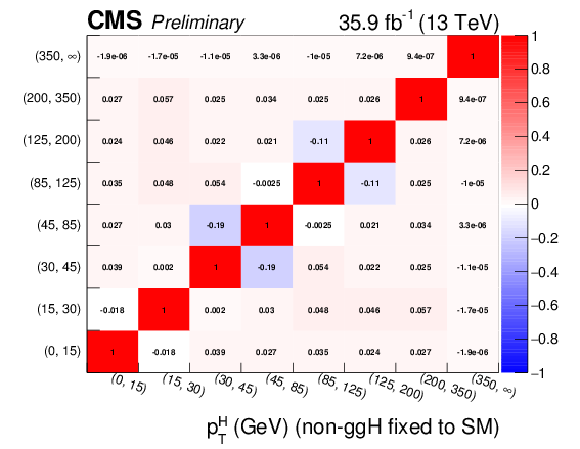
png pdf |
Figure 11-b:
Bin-to-bin correlation matrix of the pTH-spectrum, while keeping the non-gluon-fusion contributions (xH) fixed to SM expectation. |
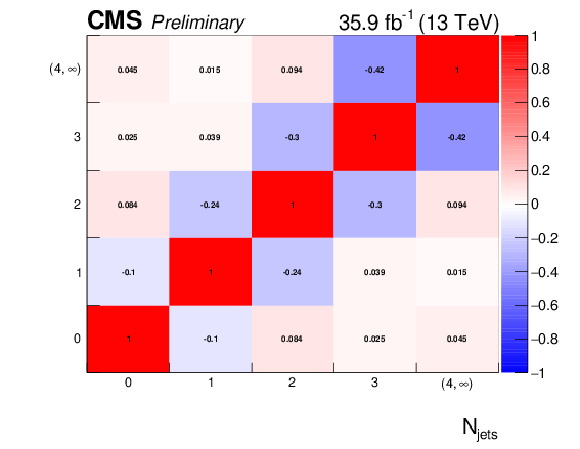
png pdf |
Figure 12:
Bin-to-bin correlation matrix of the Njets-spectrum. |
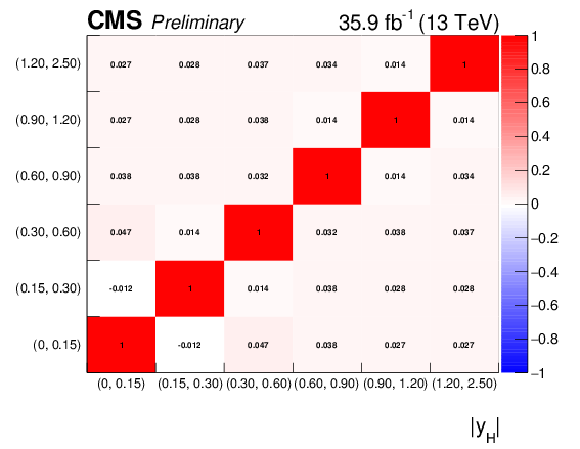
png pdf |
Figure 13:
Bin-to-bin correlation matrix of the |yH|-spectrum. |
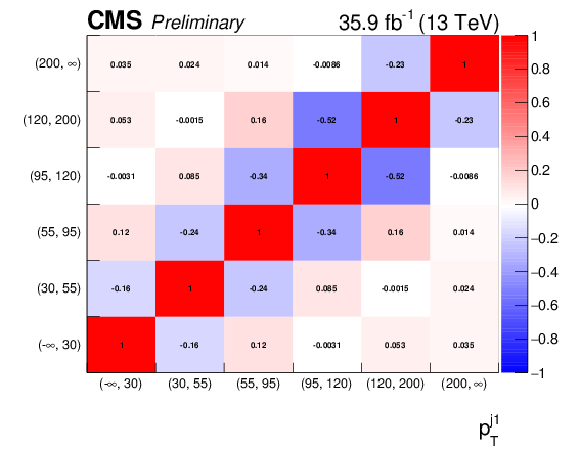
png pdf |
Figure 14:
Bin-to-bin correlation matrix of the pTjet-spectrum. |
| Tables | |

png pdf |
Table 1:
pTH bin boundaries for the H→γγ, H→ZZ and H→bˉb decay channels. |

png pdf |
Table 2:
Njets bins for the H→γγ and the H→ZZ decay channels. |

png pdf |
Table 3:
|yH| bins for the H→γγ and the H→ZZ decay channels. |

png pdf |
Table 4:
pTjet bin boundaries for the H→γγ and the H→ZZ decay channels. |

png pdf |
Table 5:
Theoretical uncertainties for the κb/κc spectra. |

png pdf |
Table 6:
Theoretical uncertainties for the κt/cg and κt/κb spectra. |
| Summary |
|
A combination of differential cross sections for the differential observables pTH, Njets, |yH| and pTjet has been presented, using 35.9 fb−1 of proton-proton collision data obtained at √s= 13 TeV with the CMS detector. The spectra obtained are based on data from the H→γγ, H→ZZ and H→bˉb decay channels. The overall uncertainty is decreased by 15% relative to that for H→γγ alone by combining the pTH spectra. The decrease is larger in the lower pTH region than in the high pTH tails. No significant deviations from the SM are observed in any differential distribution. The spectra obtained were interpreted in the Higgs coupling modifier framework, in which simultaneous variations of κb and κc, κt and κg and κt and κb were fitted to the combination of the pTH-spectrum. The limits obtained on individual couplings were −0.9<κb<0.9 and −4.3<κc<4.3, assuming the branching fractions scale with the coupling modifiers. For the charm coupling κc in particular, this measurement is competitive with those obtained from direct searches. |
| Additional Figures | |
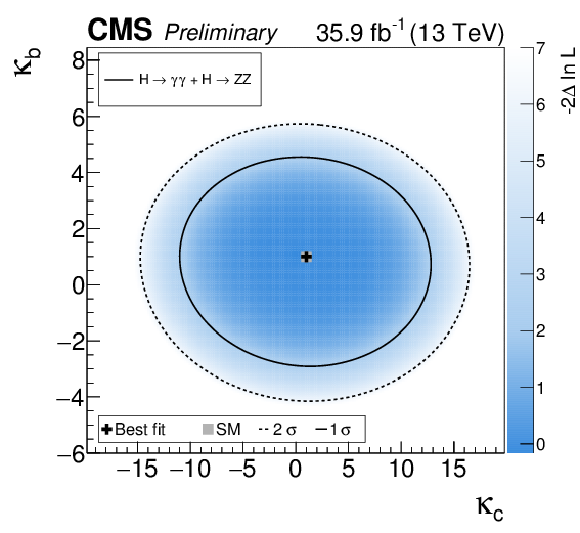
png pdf |
Additional Figure 1:
Simultaneous expected fit results for κb and κc. One and two standard deviation contours are shown for the combined (H→γγ and H→ZZ) expectation, fixing the branching fractions to the values expected from the standard model. |
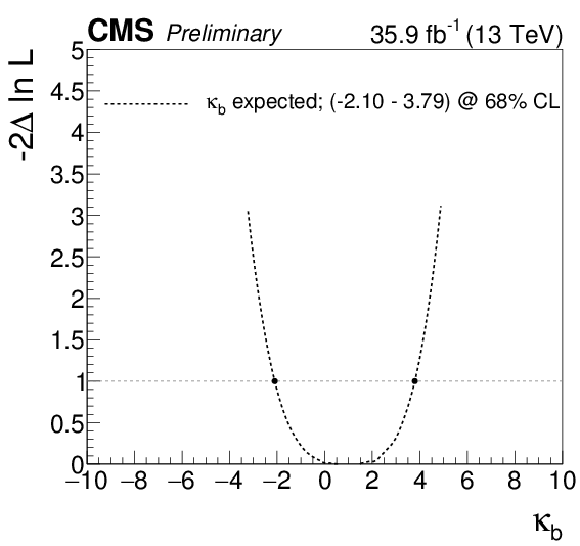
png pdf |
Additional Figure 2:
Expected fit of κb while profiling κc. The filled markers indicate the one standard deviation interval. The branching fractions were fixed to the values expected from the standard model. |
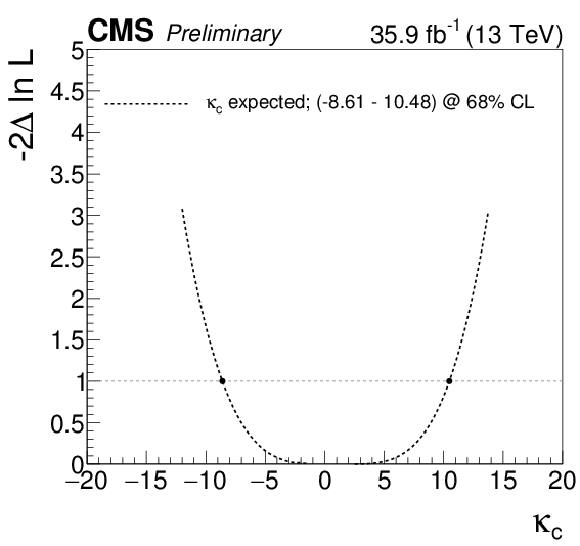
png pdf |
Additional Figure 3:
Expected fit of κc while profiling κb. The filled markers indicate the one standard deviation interval. The branching fractions were fixed to the values expected from the standard model. |
| References | ||||
| 1 | P. W. Higgs | Broken Symmetries and the Masses of Gauge Bosons | PRL 13 (1964) 508--509 | |
| 2 | F. Englert and R. Brout | Broken Symmetry and the Mass of Gauge Vector Mesons | PRL 13 (1964) 321--323 | |
| 3 | G. S. Guralnik, C. R. Hagen, and T. W. B. Kibble | Global Conservation Laws and Massless Particles | PRL 13 (1964) 585--587 | |
| 4 | ATLAS Collaboration | Observation of a new particle in the search for the Standard Model Higgs boson with the ATLAS detector at the LHC | PLB716 (2012) 1--29 | 1207.7214 |
| 5 | CMS Collaboration | Observation of a new boson at a mass of 125 GeV with the CMS experiment at the LHC | PLB716 (2012) 30--61 | CMS-HIG-12-028 1207.7235 |
| 6 | ATLAS, CMS Collaboration | Measurements of the Higgs boson production and decay rates and constraints on its couplings from a combined ATLAS and CMS analysis of the LHC pp collision data at √s= 7 and 8 TeV | JHEP 08 (2016) 045 | 1606.02266 |
| 7 | ATLAS Collaboration | Measurements of the Higgs boson production and decay rates and coupling strengths using pp collision data at √s= 7 and 8 TeV in the ATLAS experiment | EPJC76 (2016), no. 1, 6 | 1507.04548 |
| 8 | CMS Collaboration | Precise determination of the mass of the Higgs boson and tests of compatibility of its couplings with the standard model predictions using proton collisions at 7 and 8 TeV | EPJC75 (2015), no. 5, 212 | CMS-HIG-14-009 1412.8662 |
| 9 | ATLAS Collaboration | Combined measurements of Higgs boson production and decay in the H→ZZ∗→4ℓ and H→γγ channels using √s= 13 TeV pp collision data collected with the ATLAS experiment | ATLAS Conference Note ATLAS-CONF-2017-047 | |
| 10 | CMS Collaboration | Combined measurements of the Higgs boson's couplings at √s= 13 TeV | CMS-PAS-HIG-17-031 | CMS-PAS-HIG-17-031 |
| 11 | S. Dimopoulos and H. Georgi | Softly Broken Supersymmetry and SU(5) | NPB193 (1981) 150--162 | |
| 12 | E. Witten | Dynamical Breaking of Supersymmetry | NPB188 (1981) 513 | |
| 13 | F. Bishara, U. Haisch, P. F. Monni, and E. Re | Constraining Light-Quark Yukawa Couplings from Higgs Distributions | PRL 118 (2017), no. 12, 121801 | 1606.09253 |
| 14 | ATLAS Collaboration | Measurements of the Total and Differential Higgs Boson Production Cross Sections Combining the H→γγ and H→ZZ→4ℓ Decay Channels at √s= 8 TeV with the ATLAS Detector | PRL 115 (2015), no. 9, 091801 | 1504.05833 |
| 15 | ATLAS Collaboration | Search for the Decay of the Higgs Boson to Charm Quarks with the ATLAS Experiment | PRL 120 (2018), no. 21, 211802 | 1802.04329 |
| 16 | ATLAS Collaboration | Search for Higgs and Z Boson Decays to J/ψγ and Υ(nS)γ with the ATLAS Detector | PRL 114 (2015), no. 12, 121801 | 1501.03276 |
| 17 | M. Konig and M. Neubert | Exclusive Radiative Higgs Decays as Probes of Light-Quark Yukawa Couplings | JHEP 08 (2015) 012 | 1505.03870 |
| 18 | LHCb Collaboration | Search for H0→bˉb or cˉc in association with a W or Z boson in the forward region of pp collisions | LHCb Conference Note LHCb-CONF-2016-006 | |
| 19 | I. Brivio, F. Goertz, and G. Isidori | Probing the Charm Quark Yukawa Coupling in Higgs+Charm Production | PRL 115 (2015), no. 21, 211801 | 1507.02916 |
| 20 | ATLAS Collaboration | Measurements of fiducial and differential cross sections for Higgs boson production in the diphoton decay channel at √s= 8 TeV with ATLAS | JHEP 09 (2014) 112 | 1407.4222 |
| 21 | CMS Collaboration | Measurement of differential cross sections for Higgs boson production in the diphoton decay channel in pp collisions at √s= 8 TeV | EPJC76 (2016), no. 1, 13 | CMS-HIG-14-016 1508.07819 |
| 22 | ATLAS Collaboration | Fiducial and differential cross sections of Higgs boson production measured in the four-lepton decay channel in pp collisions at √s= 8 TeV with the ATLAS detector | PLB738 (2014) 234--253 | 1408.3226 |
| 23 | CMS Collaboration | Measurement of differential and integrated fiducial cross sections for Higgs boson production in the four-lepton decay channel in pp collisions at √s= 7 and 8 TeV | JHEP 04 (2016) 005 | CMS-HIG-14-028 1512.08377 |
| 24 | ATLAS Collaboration | Measurement of fiducial differential cross sections of gluon-fusion production of Higgs bosons decaying to WW∗→eνμν with the ATLAS detector at √s= 8 TeV | JHEP 08 (2016) 104 | 1604.02997 |
| 25 | CMS Collaboration | Measurement of the transverse momentum spectrum of the Higgs boson produced in pp collisions at √s= 8 TeV using H→WW decays | JHEP 03 (2017) 032 | CMS-HIG-15-010 1606.01522 |
| 26 | ATLAS Collaboration | Measurement of inclusive and differential cross sections in the H→ZZ∗→4ℓ decay channel in pp collisions at √s= 13 TeV with the ATLAS detector | JHEP 10 (2017) 132 | 1708.02810 |
| 27 | CMS Collaboration | Measurements of properties of the Higgs boson decaying into the four-lepton final state in pp collisions at √s= 13 TeV | JHEP 11 (2017) 047 | CMS-HIG-16-041 1706.09936 |
| 28 | ATLAS Collaboration | Combined measurement of differential and total cross sections in the H→γγ and the H→ZZ∗→4ℓ decay channels at √s= 13 TeV with the ATLAS detector | Submitted to PLB | 1805.10197 |
| 29 | ATLAS Collaboration | Measurements of Higgs boson properties in the diphoton decay channel with 36 fb−1 of pp collision data at √s= 13 TeV with the ATLAS detector | Submitted to PRD | 1802.04146 |
| 30 | CMS Collaboration | Measurement of differential fiducial cross sections for Higgs boson production in the diphoton decay channel in pp collisions at √s= 13 TeV | CMS-PAS-HIG-17-015 | CMS-PAS-HIG-17-015 |
| 31 | CMS Collaboration | Inclusive search for a highly boosted Higgs boson decaying to a bottom quark-antiquark pair | PRL 120 (2018), no. 7, 071802 | CMS-HIG-17-010 1709.05543 |
| 32 | LHC Higgs Cross Section Working Group Collaboration | LHC HXSWG interim recommendations to explore the coupling structure of a Higgs-like particle | 1209.0040 | |
| 33 | CMS Collaboration | Performance of photon reconstruction and identification with the CMS detector in proton-proton collisions at √s= 8 TeV | JINST 10 (2015) P08010 | CMS-EGM-14-001 1502.02702 |
| 34 | CMS Collaboration | The CMS experiment at the CERN LHC | JINST 3 (2008) S08004 | CMS-00-001 |
| 35 | J. Alwall et al. | The automated computation of tree-level and next-to-leading order differential cross sections, and their matching to parton shower simulations | JHEP 07 (2014) 079 | 1405.0301 |
| 36 | T. Sjostrand et al. | An Introduction to PYTHIA 8.2 | CPC 191 (2015) 159--177 | 1410.3012 |
| 37 | P. Skands, S. Carrazza, and J. Rojo | Tuning PYTHIA 8.1: the Monash 2013 Tune | EPJC 74 (2014) 3024 | 1404.5630 |
| 38 | K. Hamilton, P. Nason, and G. Zanderighi | MINLO: Multi-Scale Improved NLO | JHEP 10 (2012) 155 | 1206.3572 |
| 39 | A. Kardos, P. Nason, and C. Oleari | Three-jet production in POWHEG | JHEP 04 (2014) 043 | 1402.4001 |
| 40 | M. Dasgupta, A. Fregoso, S. Marzani, and G. P. Salam | Towards an understanding of jet substructure | JHEP 09 (2013) 029 | 1307.0007 |
| 41 | A. J. Larkoski, S. Marzani, G. Soyez, and J. Thaler | Soft Drop | JHEP 05 (2014) 146 | 1402.2657 |
| 42 | G. Cowan, K. Cranmer, E. Gross, and O. Vitells | Asymptotic formulae for likelihood-based tests of new physics | EPJC71 (2011) 1554 | 1007.1727 |
| 43 | P. C. Hansen | The L-curve and its use in the numerical treatment of inverse problems | in Computational Inverse Problems in Electrocardiology, pp. 119--142 Southampton: WIT Press | |
| 44 | M. Grazzini, A. Ilnicka, M. Spira, and M. Wiesemann | Effective Field Theory for Higgs properties parametrisation: the transverse momentum spectrum case | in 52nd Rencontres de Moriond on QCD and High Energy Interactions (Moriond QCD 2017) La Thuile, Italy, March 25-April 1, 2017 2017 | 1705.05143 |
| 45 | A. Banfi, P. F. Monni, and G. Zanderighi | Quark masses in Higgs production with a jet veto | JHEP 01 (2014) 097 | 1308.4634 |
| 46 | G. Bozzi, S. Catani, D. de Florian, and M. Grazzini | The q(T) spectrum of the Higgs boson at the LHC in QCD perturbation theory | PLB564 (2003) 65--72 | hep-ph/0302104 |
| 47 | T. Becher and M. Neubert | Drell-Yan Production at Small qT, Transverse Parton Distributions and the Collinear Anomaly | EPJC71 (2011) 1665 | 1007.4005 |
| 48 | P. F. Monni, E. Re, and P. Torrielli | Higgs Transverse-Momentum Resummation in Direct Space | PRL 116 (2016), no. 24, 242001 | 1604.02191 |
| 49 | LHC Higgs Cross Section Working Group Collaboration | Handbook of LHC Higgs Cross Sections: 4. Deciphering the Nature of the Higgs Sector | 1610.07922 | |

|
Compact Muon Solenoid LHC, CERN |

|

|

|

|

|

|